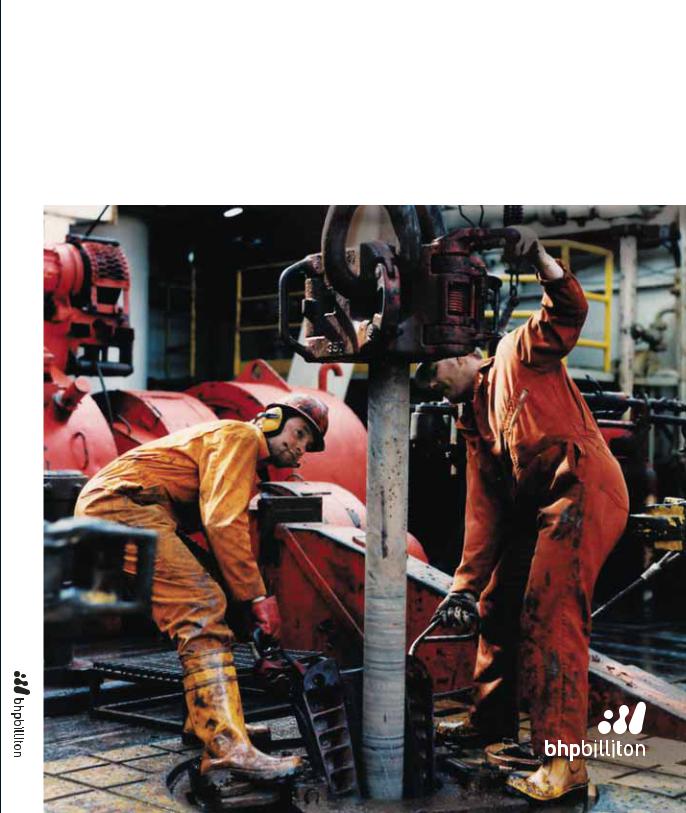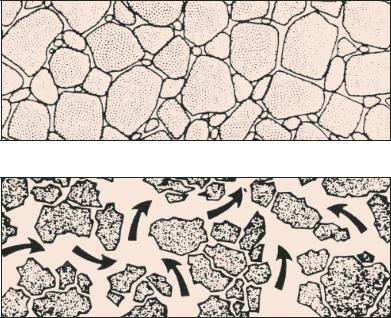
SpeakingOilGas
.pdf
GAS&OIL SPEAKING
SPEAKING
OIL&GAS
Written for BHP Billiton Petroleum Pty Ltd by Rick Wilkinson
SPEAKING
OIL&GAS
Written for BHP Billiton Petroleum Pty Ltd by Rick Wilkinson

First published by BHP Petroleum Pty Ltd as Speaking of Oil in April 1988 Revised as Speaking of Oil & Gas in June 1995 and November 1997
This edition revised as Speaking Oil & Gas and published by
BHP Billiton Petroleum Pty Ltd in June 2006
© BHP Billiton Petroleum Pty Ltd in 1988, 1995, 1997, 2006
ISBN 0-646-45386-6
Printed in Australia
The cover is printed on 250 gsm Impress Silk which is produced in European mills with full ISO 9001, ISO 14001 and Eco Management and Audit Scheme (EMAS) certification. Primary fibre is sourced from sustainable forests and all pulp used is either Elemental Chlorine Free (ECF) or Totally Chlorine Free (TCF).
The text pages are printed on 130 gsm Revive Silk, the only Australian made coated paper that uses 35% recycled fibre. Fibre is sourced from ISO 14001 certified plantations and suppliers, and is bleached using TCF and ECF technology.
Contents
|
Foreword |
iv |
|
Introduction |
1 |
Chapter 1. |
Geology |
3 |
Chapter 2. |
Surveys |
18 |
Chapter 3. |
Drilling |
43 |
Chapter 4. |
Evaluation & Production |
69 |
Chapter 5. |
Permits |
91 |
Chapter 6. |
Public Reports & Reporting |
102 |
Chapter 7. |
Taxation, Pricing & Marketing |
110 |
Chapter 8. |
Health, Safety, Environment |
|
|
& Community |
129 |
Chapter 9. |
Economics |
148 |
Chapter 10. |
Downstream Processes |
155 |
Appendix 1. |
Petroleum Specialists |
163 |
Appendix 2. |
Conversion Factors |
167 |
|
Glossary |
170 |
INTRODUCTION |
iii |
Foreword
BHP Billiton Petroleum Pty Ltd is a subsidiary of natural resources company BHP Billiton. BHP, as it was then known, began in the petroleum business during the late 1950s when it gained title to explore a vast area of what was then frontier territory in Bass Strait, a stretch of ocean off southeastern Australia between Victoria and Tasmania encompassing three offshore sedimentary basins. In the second half of the 1960s BHP Billiton participated in an amazing run of discoveries in one of these basins — the Gippsland Basin — which catapulted the company to the forefront of Australia’s oil and gas industry.
With Bass Strait as a stepping stone, BHP Billiton has expanded rapidly over the last 40 years to become Australia’s biggest and most successful petroleum company, both at home and overseas, with interests and activities in a number of countries. In the 2005 financial year, BHP Billiton produced 119 million barrels of oil equivalent (combined oil and gas) or about 326,000 barrels of oil equivalent per day. In June 2005 the company had proved reserves of 1407 million barrels of oil equivalent, and average reserves replacement for the three years 2002–2005 stood at 99 per cent.
In order to aid public understanding of the petroleum business, BHP Billiton commissioned journalist/author Rick Wilkinson1 to compile a handbook explaining the technical and regulatory aspects of the search for, and production of, petroleum in Australia. The book was first published in 1988, then again in 1995 and 1997.
This revised 2006 edition brings the reader up to date with the latest technical advances and expands its coverage to include the key fiscal and regulatory petroleum regimes around the world.
1.Rick Wilkinson is the author of a number of books about the petroleum industry, including: A Thirst for Burning – the story of Australia’s oil industry; Where God Never Trod – Australia’s oil explorers across two centuries; Well, Well, Well – behind Australia’s wildcat names; and Once Upon a Wildcat – images from Australia’s petroleum story.
iv |
SPEAKING OIL & GAS |

Introduction
Petroleum is among the minerals that have been used by man since earliest times, certainly prior to metals and coal.
Names like ‘Sweat of the Devil’ and ‘Shining Water’ were coined by primitive peoples who made use of the unusual surface occurrences.
The use of petroleum during the ages
INTRODUCTION |
1 |
The word petroleum is derived from the Greek word ‘petros’, meaning rock, and the Roman word ‘oleum’, meaning oil.
Earliest uses included caulking boats, fuelling lamps and preserving mummies. Written reports on petroleum come from as far back as 4000 BC and its use is well documented from countries as far apart as Egypt, China and Mexico.
The modern era can be traced back to Edwin Drake’s 1859 discovery well in Pennsylvania, yet it is only in the last four or five decades that there has been any real understanding of petroleum geology.
The technology to begin perfecting the search for, and exploitation of, oil and gas has an even shorter history and there are still numerous questions to be answered satisfactorily. Nevertheless petroleum has progressed from humble beginnings to be a cornerstone of civilization and the key element in an international industry.
There are signs that it will continue to be a major source of the world’s energy well into the 21st century.
2 |
SPEAKING OIL & GAS |

Chapter 1. GEOLOGY
Sedimentary basins
Sedimentary basins are fundamental to petroleum geology because most of the world’s commercial oil and gas fields have been found within them. The basins develop over tens of millions of years and gradually fill with fragmented material which hardens into rock layers within which petroleum is formed and trapped.
Normally the history of a basin begins with subsidence of the land which allows an invasion by the sea. Surrounding mountains and hills are slowly eroded by wind, rain and ice, aided by the internal stresses caused by heat and cold. Particles of rock are gradually washed down streams and rivers. These particles will be deposited as the rivers lose energy in a number of environments such as lakes, the sea or deltas.
A phase that occurs early in the history of the basin is transgression, where the sea extends over the land. As time goes by, the amount of sediment brought by rivers increases and begins to overtake the incoming sea.
GEOLOGY |
3 |

Eon |
Era Period |
||
|
|
Quarternary |
|
|
CAINOZOIC |
Tertiary |
|
|
|
||
PHANEROZOIC |
MESOZOIC |
Cretaceous |
|
|
|
||
|
|
Jurassic |
|
|
|
Triassic |
|
|
|
Permian |
|
|
PALAEOZOIC |
Carboniferous |
|
|
Devonian |
||
|
|
||
|
|
Silurian |
|
|
|
Ordovician |
|
|
|
Cambrian |
|
PRECAMBRIAN |
PROTEROZOICARCHAEAN |
Late |
|
Middle |
|||
|
|
||
|
|
Early |
|
Epoch |
Age* |
Record of Life |
Recent 0.015
Pleistocene 1.8
Man
Pliocene 5.0
Angiosperms
Grasses
Miocene 24.0
Marsupials |
Eucalypts |
Oligocene 37.0
Cetaceans
Starfish
Eocene 53.5
Conifers
Birds
Paleocene 65.0
Foraminifera
135 |
|
|
|
|
|
Chelonids |
Dinosaurs |
Cycads |
|
|
|
|||
195 |
Sponges |
Plesiosaurs |
|
|
Echinoids |
|
|
||
|
|
|
|
Ferns |
235 |
|
Ostracods |
|
|
290 |
|
|
|
|
Pelecypods Amphibians Insects |
Equisetales |
Glossopteris |
||
Crinoids |
|
|
|
|
345 |
|
|
|
|
|
Bryozoa Sharks |
Lepidodendroids |
||
410 |
|
|
|
|
Brachiopods |
Fish |
Ammonoids |
|
|
|
|
|
||
435 |
Stromatoporoids |
Baragwanathia |
||
|
|
|||
|
|
|
(land plant) |
|
Corals |
|
Nautiloids |
|
|
490 |
|
Graptolites |
|
|
|
|
|
|
|
Gastropods |
|
Trilobites |
|
|
570 |
|
|
|
|
|
|
|
|
|
1400 |
|
|
Bacteria |
Algae |
|
Conodonts |
Worms |
||
|
|
|||
1800 Jellyfish |
Archaeocyathids |
|
|
|
2300 |
|
|
|
|
|
|
Indicates forms extinct |
|
|
>3800 |
|
All other forms range to the present |
||
(greatest age |
|
* Age at base of period or epoch |
|
|
so far measured) |
|
in millions of years |
|
|
The geological time-scale Courtesy of Geoscience Australia
4 |
SPEAKING OIL & GAS |

The subsidence fills, so that the newly arriving material is distributed around the edges to form mud banks, beaches and deltas at the river mouths. Slowly the shoreline builds up, pushing the sea back in a phase known as regression.
Such a period of transgression and regression is called a sedimentary cycle and there are many such cycles during the formation of a sedimentary basin. Layer after layer of sediment is deposited and compressed by the increasing weight of material above to form sedimentary rock.
The layers themselves will vary in composition — sand grains form sandstone, fine muds form shale, broken corals and shells form limestone. At times whole coral reefs fringing the coastline are buried, giving a hard core of limestone surrounded by sandstone and shales.
A rock is porous when it has many tiny spaces, or pores
A rock is permeable when the pores are connected
GEOLOGY |
5 |
